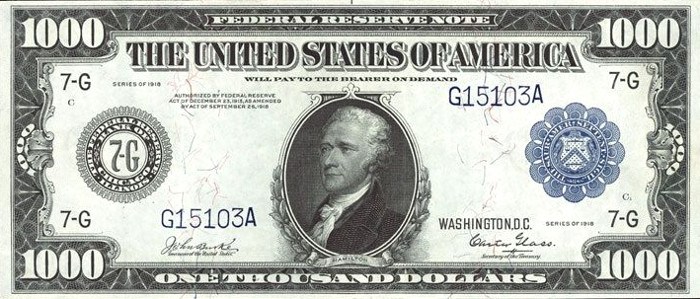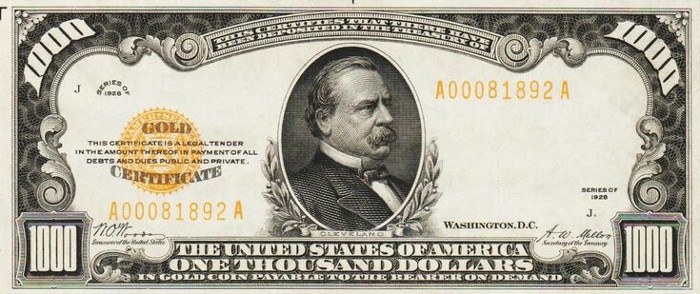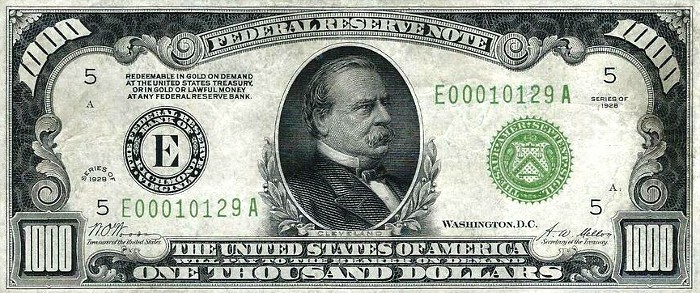The $1000 dollar bill is a real bill that had been in circulation for a long time. Here we examine its history, the different series, and what the current values are.
Who Is on the 1000 Dollar Bill?
There were many different series of $1000 dollar bills, but the man pictured on the most common series is President Grover Cleveland. Therefore he is considered to be the face of the $1000 dollar bill. Alexander Hamilton was also featured on several different series.
History
The 1000 dollar bill has a long history dating back hundreds of years. The Confederacy issued out their own 1000 dollars bills during the Civil War and the US federal government started issuing them out nationally in the 1860s. Back then, these bills were only handled by banks and rich individuals. There was no need for an individual to store or save them because currency wasn't collectible at the time and the value of the bills could be earning interest.
The gold standard was repealed in 1933 by President Franklin Roosevelt. As a response, the government issued out 1934 gold certificates which included a $1000 dollar denomination. These high-value gold certificates were used between banks and they were not issued out to the public. Although collectors can find them for sale today.
The 1934A series was the last issued series for $1000 dollar bills. However these bills remained in circulation for many years later. They were still in circulation up to around the early 1970s. For those reasons, most $1000 dollar bills are not as valuable as you would expect. Although they still sell above face value and there are some rare series.
The $1000 bill wasn't the only large-denomination bill printed by the US government. There was also the $500 bill, $5,000 bill, and $10,000 bill. Large denomination bills are not used today for a few different reasons. The main reasons include potential issues with counterfeiting and the rise of electronic cash. Inflation has risen over the years but there still isn't much of a need for large denominations because most financial transactions are now digital. Instead of making a $1000 purchase with cash, the majority of people elect to use a credit card while others write a check.
Value
There are rare $1000 bill series and then there are common ones. The rare series are extremely rare and only come up at exclusive auctions where the prices will exceed $100,000.
For the most common series (1928, 1934, or 1934A Federal Reserve notes) there isn't a significant price difference. But it's still important to know the series type because there are some rare varieties for these series. The common series sell for around $2,250 to $2,500 in very fine condition, and much more in uncirculated condition.
Besides condition, there are other factors which can affect the value. For example there are star notes which are bills with a star after the serial number. These notes are very rare. In addition, notes with serial numbers under 100, known as low serial numbers, command a premium. Keep reading below to learn more about some of the most common series.
Series
One thousand dollar bills came in several different series. Some series are extremely rare with only a handful known to exist. Therefore we are going to examine the more common series that you can buy today on the open market.
1918 $1000 Federal Reserve Note

This is the most common large size note but it's still very rare. The 1918 $1000 Federal Reserve note features Alexander Hamilton on the front and a large bald eagle on the reverse side.
Most 1918 series $1,000 notes are worth around $9,500 in very good condition. In very fine condition the value is around $18,500. In extremely fine condition the value is around $35,000-45,000. Notes issued from the Federal Reserve Banks of Boston, Dallas, and Minneapolis are more valuable.
1928 $1000 Gold Certificate

The 1928 $1000 Gold Certificate is unique looking because there is a large empty space on the front right side of the bill. Some people may think of it as a misprint but its actually the standard design.
The government printed 28,800 gold certificates but there are most likely only a few hundred in existence today. There are no varieties or star notes so condition is the only valuation factor.
The 1928 series $1,000 gold certificates are worth around $5,500 in very good condition. In very fine condition the value is around $12,500. In extremely fine condition the value is around $30,000. In uncirculated condition the price is around $90,000 for gold certificates with an MS 63 grade.
1928 $1000 Federal Reserve Note

A little over 1.1 million 1928 $1000 Federal Reserve notes were printed and there are estimated to be about 68,000 still in existence today. So this is a relatively common one-thousand dollar bill. All 12 federal reserve banks issued this note. Notes issued from the Federal Reserve Bank of Boston are much more valuable.
There are the standard notes, and then there are the star notes which are overprint notes with a star symbol next to the serial number.
The seal color can also make a difference in value. The light green seals (LGS) are a little more valuable. They were issued from the banks of St. Louis, Richmond, San Francisco and Kansas City.Most 1928 series $1,000 notes are worth around $2,250 in very fine condition. In extremely fine condition the value is around $4,000. In uncirculated condition the price is around $8,500 for notes with an MS 63 grade.
The 1928 series $1,000 star notes are more rare and more valuable. Most of these notes are each worth around $32,500 in very fine condition. In extremely fine condition the value is around $60,000. Notes issued from the Federal Reserve Banks of Atlanta, Boston, Dallas, Kansas City, and San Francisco are very rare and much more valuable.
1934 1000 Dollar Federal Reserve Note
The US government issued out both the 1934 series and the 1934A series. There is not much difference between the two series and they both have the same design as the 1928 series. In total there were about 1.5 million of these notes printed. Star notes are available and they command a much higher premium.
Notes issued from the Federal Reserve Bank of Minneapolis are more valuable. In addition, the seal type can also have an impact on value. There are two different seal types for the 1934 series: light green seals and dark green seals. The light green seals are much more rare and normally they are only seen on notes with serial numbers under 10,000. The 1934A series only has the dark seal type.
Most 1934 series and 1934A series $1,000 notes are worth around $2,250 in very fine condition. In extremely fine condition the value is around $4,500. In uncirculated condition the price is around $8,500 for notes with an MS 63 grade.
Most 1934 series and 1934A series $1,000 star notes are worth around $12,000 in very fine condition. In extremely fine condition the value is around $16,000. In uncirculated condition the price is around $20,000 for notes with an MS 63 grade. Star notes issued from the Federal Reserve Banks of Boston and San Francisco are less valuable.
Grading System
Very good- A circulated note that has considerable wear to it. There might be one or two tears on the edge of the note. The note may be discolored, dark in appearance, or limp.
Very fine- A note that has been in circulation but not for a long time. The note is still relatively crisp. There may be some creases, folds, or light smudges.
Extremely fine- A note that shows small signs of having been in circulation. The note will be bright and it will have almost all of its original crispness. There might be one or two minor creases or folds but there are no stains, discolorations, or tears.
MS 63 choice uncirculated- A note that shows no signs of ever having been in circulation. The note still has its original crispness. The note is also well-centered.
Conclusion
The $1000 dollar bill can be quite valuable. If you have one then it's important to do your research and find out if you have a rare variety or not. Rare varieties can be quite valuable.
Sources:
